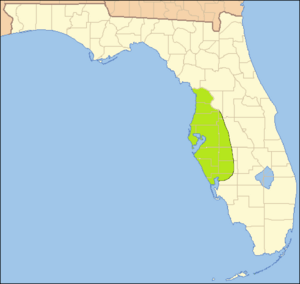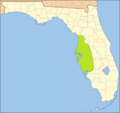Safety Harbor culture facts for kids
The Safety Harbor culture was a way of life for Native American people living on the central Gulf Coast of Florida. They lived there from about 900 CE until after 1700. We know about this culture because of special pottery found in their burial mounds. The culture is named after the Safety Harbor site, which was a very important place for these people. This site was likely the main town of the Tocobaga, one of the best-known groups of the Safety Harbor culture.
The Safety Harbor people lived in groups called chiefdoms. Most of their villages were along the coast of Tampa Bay and the nearby Gulf of Mexico. Each chiefdom might have covered about 15 miles (24 km) of coastline and stretched about 20 miles (32 km) inland. Every chiefdom had a main town, like a capital city. This town had a special temple mound and a central open area called a plaza.
Archaeologists have found fifteen such main towns. They are located along the Florida Gulf coast from southern Pasco County to northern Sarasota County. This area includes all of the Tampa Bay area. Only one main town has been found further inland.
Spanish visitors described these villages, and their descriptions match what archaeologists have found. The main towns had a central rectangular plaza. A large, flat-topped mound, up to 20 feet (6.1 m) high, stood on one side of the plaza. This mound could be up to 130 feet (40 m) long on each side at its base. Buildings were on top of the mound, and a ramp led down to the plaza. A burial mound was usually nearby. Shell mounds, or middens (trash piles), were often along the shore. Sometimes other middens were around the plaza. The plaza itself was kept very clean. Important people lived in houses around the plaza. Other people lived in huts further away. The Spanish said the chief and his family lived on the main mound. They also mentioned a "temple" (which was probably a place to prepare bodies for burial) on the opposite side of the plaza.
Contents
Where and When They Lived
The Safety Harbor culture was found along the central Gulf coast of Florida. It stretched from Tarpon Springs to Sarasota. Some evidence suggests it reached the Aucilla River to the north and Charlotte Harbor to the south.
The main area of the Safety Harbor culture was around Tampa Bay. This included all of what is now Hillsborough and Pinellas counties. It also covered southern Pasco County and northern Manatee County. To the north, the area between the Withlacoochee River and the Gulf coast was called "Northern Safety Harbor." This included Citrus, Hernando, and northern Pasco counties.
South of Tampa Bay, the "Manasota Safety Harbor" area included southern Manatee County, Sarasota County, and northern Charlotte County. Inland, DeSoto, Hardee, and most of Polk County were part of the "Inland Safety Harbor" area.
The Safety Harbor culture grew from an earlier group called the Manasota culture. This earlier culture was related to the Weeden Island culture. The Safety Harbor people were also influenced by the Mississippian culture. This influence can be seen in some of their pottery designs. However, the Safety Harbor people did not start farming large amounts of crops like the Mississippian culture did. Because of this, their culture did not fully become Mississippian.
Archaeologists divide the Safety Harbor culture into four time periods. These periods are based on changes in their decorated pottery and the presence of European items.
- Englewood Phase: 900 to 1100 CE (before Europeans arrived).
- Pinellas Phase: 1100 to 1500 CE (before Europeans arrived).
- Tatham Phase: 1500 to 1567 CE (when the Spanish first arrived).
- Bayview Phase: 1567 to 1725 CE (during the Spanish colonial period).
Mounds and Their Purpose
The Safety Harbor culture is known for its burial mounds. These mounds contain pottery with special designs and symbols. Most pottery used for daily life, found in village areas, was plain.
Major Safety Harbor sites also had platform mounds, often called "temple mounds." Spanish explorers described a temple on top of an earth mound in a Safety Harbor village. Experts believe these "temples" were likely charnel houses. These were places where bodies were prepared and stored before being buried.
Many of these temple mounds have been destroyed since the 1800s. However, at least fifteen have been recorded around Tampa Bay and on the nearby Gulf coast. These temple mounds were rectangular with flat tops. They usually had a ramp leading up to the top on one side.
Important Temple Mounds
Here are some of the known Safety Harbor sites that had "temple" mounds:
- Anclote Temple Mound, near the Anclote River (now gone).
- Anderson/Narvaez Temple Mound, in St. Petersburg.
- Bayshore Homes Temple Mound, in St. Petersburg (now gone).
- Dunedin Temple Mound, in Dunedin (now gone).
- Fort Brooke Temple Mound, at the site of Fort Brooke in Tampa (now gone).
- Harbor Key Temple Mound, on Bishop Harbor in Manatee County.
- Madira Bickel Temple Mound, in Manatee County (a protected historical site).
- Maximo Point Temple Mound, in St. Petersburg.
- Mill Point Temple Mound on the Alafia River (now gone).
- Pillsbury Temple Mound, in Manatee County (mostly gone).
- Pinellas Point Temple Mound, in St. Petersburg.
- Safety Harbor Temple Mound, at Safety Harbor site in Safety Harbor. This is the main site that gave the culture its name.
- Snead Island Temple Mound, in Manatee County.
- Weeden Island Temple Mound, at Weedon Island Preserve in St. Petersburg (now gone).
- Whitaker Temple Mound, on Sarasota Bay (now gone).
Archaeologists have studied the size and shape of these mounds. They believe the mounds might show a kind of leadership structure. The four largest mounds could have been regional centers, like main cities. The smaller mounds might have been in smaller villages and used for different purposes. However, some experts think that the main political centers might have moved over time. This means not all temple mounds were used at the same time.
Burial Mounds
Burial mounds with Safety Harbor pottery are common around Tampa Bay. They are also found in other areas where the culture lived. For example, burial mounds have been found at Weeki Wachee Springs and the Tatham mound.
The Tocobaga people kept the bodies of recently deceased people in their temples or charnel houses. They would keep them there until only the bones remained. Spanish visitors said the bodies were wrapped in painted deer hides and stored in wooden boxes. One Spanish captive said he had to guard a temple at night to keep wolves away from the bodies.
After the bones were clean, they would be buried. A Spanish story about a chief's funeral says his body was prepared over two days. Then, his skeleton was put back together and left in the temple for four days while people fasted. After this, everyone in the town would take the bones and place them in a burial mound. Sometimes, bodies were burned (cremated) and then buried in the mound where the charnel house stood.
Why Mounds Disappeared
Sadly, many of the temple mounds, burial mounds, and shell middens in the Tampa Bay area were destroyed. This happened quickly in the early to mid-1900s as the local population grew. Developers wanted to flatten land near the water. Road builders also found that bulldozed shell mounds were excellent material for filling roads.
Today, state and federal laws protect sites that contain human remains or are on public land. However, protecting other archaeological sites on private land is optional. People are encouraged to preserve them with tax benefits and other rewards.
Daily Life of the Safety Harbor People
The Spanish reported that the Safety Harbor people had four social groups: chiefs, headmen, warriors, and ordinary people. They also had slaves, who were often Europeans or people from other tribes captured in battles. Chiefs were very important. One chief visited a Spanish leader by being carried on another man's back. Chiefs often married the sisters of other chiefs to build alliances.
The Safety Harbor people ate many different foods. They caught fish and shellfish. They hunted deer, turtles, and dogs. They also gathered plants like watercress, pumpkins, and "cabbage" from palmettos or cabbage palms. They also ate beans. They might have grown a small amount of corn, but it was not a major part of their diet.
They used bows and arrows for hunting. The arrowheads were made of stone or stingray stingers. Their houses were built with wooden posts and covered with palm leaves. Their "temples" (charnel houses) and other important buildings were decorated with wood carvings. The pottery they used every day was mostly plain. But the special pots used in ceremonies and found in burials had unique decorations. These decorations are a key feature that helps us identify the Safety Harbor culture.
Chiefdoms and Their Leaders
The name "Tocobaga" is often used for all the Native American groups in the Tampa Bay area during the first Spanish colonial period (1513-1763). But strictly speaking, Tocobaga was the name of a specific chiefdom, its main town, and its chief. This chiefdom was probably located at the Safety Harbor site.
Other Safety Harbor chiefdoms mentioned by the Spanish include:
- Mocoso, on the east side of Tampa Bay.
- Pohoy (also called Capaloey), possibly on the north side of Hillsborough Bay.
- Uzita, on the south side of Tampa Bay.
It is not known what these chiefdoms shared besides the Safety Harbor culture. One Spanish captive, Hernando de Escalante Fontaneda, described Tocobaga as the "King head chief of that district." But he also said Tocobaga and Mocoso were independent "Kingdoms."
The records from the de Soto expedition (which did not mention Tocobaga) say that Mocoso and Uzita were under a chief named Urriparacoxi. This chief lived about 30 leagues (around 90 miles or 145 km) east or northeast of Tampa Bay. The people of Mocoso and Uzita were noted for speaking different languages.
After the de Soto expedition, Mocoso and Uzita are not mentioned again in Spanish records. The chiefdom of Tocobaga seems to have been the most powerful group in the Tampa Bay area in the late 1500s. This was especially true when Pedro Menéndez de Avilés visited in 1567. However, Tocobaga's power seemed to fade in the 1600s. First the Pohoy, and then the Calusa, became more powerful in the Tampa Bay area.
By around 1700, the Safety Harbor culture had almost disappeared. This was mainly due to diseases brought by Europeans and attacks from other Native American groups from the north.
Images for kids
See also
 In Spanish: Cultura Safety-Harbor para niños
In Spanish: Cultura Safety-Harbor para niños



